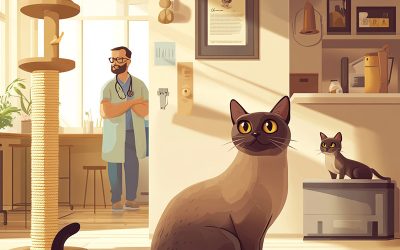Are Collars Safe for Cats? A Look at the Research
Read the full research paper here
Many cat owners worry about whether collars are safe for their feline friends. Some fear their cat might get caught on something or even injure itself while wearing a collar. But collars are important; they help lost cats return home and can also carry devices to prevent hunting. So, should your cat wear a collar? Let’s break down what the research says in a way that’s easy to understand.
The Purpose of Cat Collars
Collars serve two major purposes:
- Identification: If your cat gets lost, an ID tag makes it easy for someone to return them home.
- Hunting Prevention: Some collars have bells or bright colors to warn birds and small animals, reducing your cat’s impact on wildlife.
Despite these benefits, some people worry that collars can be dangerous. A common concern is that cats might get their collars stuck on objects or caught on their own limbs. This article looks at what the research says about collar safety.
What the Research Found
A study from Murdoch University in Australia examined how often collars actually cause injuries or accidents. Researchers collected data from three groups:
- Veterinarians who treat collar-related injuries.
- Cat owners from the general public who reported their experiences.
- Cat welfare group members who are often more aware of cat safety issues.
Here’s what they found:
- Most cats wearing collars experience no serious problems.
- Collar injuries are rare. Only about 3–6% of cats needed veterinary care due to a collar.
- Collar-related deaths are extremely rare. In the study, only one case was reported among over 100 surveyed owners.
- More common dangers to outdoor cats include road accidents and fighting with other cats, both of which are far more frequent and serious than collar injuries.
Collars vs. Other Cat Dangers
The study compared collar-related problems with other risks outdoor cats face:
- 62% of owners had lost a cat to a road accident.
- 53% had a cat injured in a fight that needed veterinary care.
- Only 27% of owners reported a minor collar incident, and even fewer (3%) had an actual collar-related injury.
Clearly, road traffic and fighting injuries are much bigger risks to cats than collars.
What Types of Collars Are Safest?
Not all collars are the same. Here’s how different types compare:
| Collar Type | Owner Safety Rating |
|---|---|
| Breakaway collar (designed to snap open if stuck) | Safest |
| Breakaway collar with stretch insert | Also safe |
| Elastic collar (stretches but does not break open) | Less safe |
| Standard buckle collar (no stretch, no breakaway) | Least safe |
The safest option is a breakaway collar, which pops open if pulled too hard. Many veterinarians and owners prefer these because they reduce the risk of a cat getting stuck.
What About Cats Losing Their Collars?
Some owners avoid collars because they believe their cat will just lose them. The study found that while some cats do lose collars, many wear them comfortably with no issues. If a cat loses a collar, it’s usually a sign that the fit wasn’t quite right. A well-fitted collar should allow you to slide two fingers between the collar and the cat’s neck.
Should Your Cat Wear a Collar?
Based on the research, yes; as long as it’s the right kind. The risks of collars are very low, especially compared to other outdoor dangers like traffic and fights. Collars with ID tags increase the chances of a lost cat being returned home, and collars with hunting deterrents help protect wildlife.
If your cat goes outdoors, a properly fitted breakaway collar with an ID tag is the best choice. It provides safety, helps them find their way home, and can reduce their impact on wildlife.
Tips for Cat Owners
If you decide to put a collar on your cat, here are some tips to keep it safe and comfortable:
- Choose a breakaway collar to prevent accidents.
- Check the fit regularly; two fingers should fit between the collar and your cat’s neck.
- Replace the collar if it gets damaged or worn out.
- Look for signs of discomfort. If your cat keeps scratching at it or seems unhappy, adjust the fit or try a different type.
Conclusion
Collars are not a major safety hazard for cats, and they have many benefits. Research shows that collar injuries are rare, while road accidents and fights are far more dangerous. If you choose a breakaway collar, check the fit regularly, and use an ID tag, you’re doing your cat a favor by keeping them safer and more likely to return home if they get lost.
So, if you were unsure about giving your cat a collar, the science is in; collars are generally safe and beneficial, as long as they’re the right type!
Where to Buy
As a club, we do not advocate for any particular retailer, but here are a few small, locally owned businesses in New Zealand that you can support. With so many purchasing options available today (including supermarkets, large retail chains, low-cost marketplaces, and global resellers) it’s important to do your research. Remember, cheap isn’t always a good deal, and price alone isn’t always an indicator of quality.
Purr Meow Woof A Canterbury-based online retailer offering a range of breakaway collars and other pet products. You’ll also find Purr Meow Woof at most cat shows in the Canterbury region, where they showcase their latest products.
LedandCollared A Wellington-based online retailer that designs and manufactures their own collars. They offer customisation, ID tags, and harnesses for both cats and dogs. Be sure to check out their article, “Cat Breakaway Safety Collar vs. Standard Cat Collar: Which is Safer?”, which explores the key differences and safety benefits of each type of collar.
Cat Store Based in Auckland, Cat Store is more than just an online pet supply shop. In addition to breakaway cat collars, they offer a selection of cat-themed gifts for cat lovers.
Some Additional Links
https://www.pdinsurance.co.nz/blogs/cat-collars-pros-and-cons/. This PD Insurance explores the Pros and Cons of cat collars; in particular the breakaway collar.



0 Comments